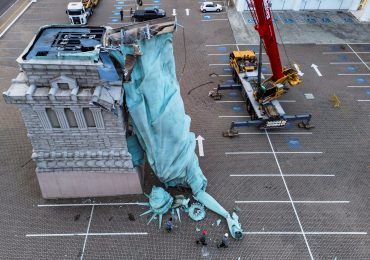The House is set to make history on Tuesday by voting on the impeachment of Homeland Security Secretary Alejandro Mayorkas. If the measure draws enough support, It would be only the second time a cabinet member has even been impeached. The first time happened almost 150 years ago with William Belknap, President Ulysses Grant’s Secretary of War who found himself caught up in a brazen kickback scheme at a time of unparalleled economic expansion, few regulations and too many temptations.
[time-brightcove not-tgx=”true”]
Belknap was a Civil War hero who had fought in the battles of Shiloh and Vicksburg and was promoted to Brigadier General in 1864. Grant, who admired Belknap and had befriended the Princeton-educated lawyer and former Iowa legislator, appointed him to be his Secretary of War in 1869. After serving seven years in President Grant’s cabinet, Belknap was charged with “criminally disregarding his duty” and “basely prostituting his high office to his lust for private gain.”
Belknap’s downfall was his decision to abuse his authority to appoint “sutlers” or civilian merchants who ran trading posts that served military outposts. At the urging of his second wife, Carita, Belknap named a New York businessman who was married to Carlita’s close friend, Caleb Marsh, to run the trading post at Fort Sill in the Oklahoma territory. However, Fort Sill already had a trader, John Evans, who did not want to relinquish the post. A compromise was reached via a generous kickback. Evans was to pay Marsh for the privilege of sharing the post. Since Marsh was indebted to the Belknap’s for giving him the lucrative job, he agreed to split the pay-off money with Carita.
“Carita engineered the plan that would ultimately bring about Belknap’s downfall,” says says Cecily N. Zander, assistant professor of history at Texas Woman’s University.
Belknap’s blatantly corrupt actions epitomized what Mark Twain dubbed the Gilded Age. His $8,000 a year salary (roughly $230,000 in today’s dollars) was not enough to maintain the luxury lifestyle that either his second wife Carita or his third wife Amanda desired. After Carita died in 1870, her sister Amanda Bowers became Belknap’s third wife and the kickback payments continued. Prior to her marriage to Belknap, she took an 18-month trip to Europe where she acquired expensive furniture and a trousseau from a Paris designer. She was known in Washington’s high society for her extravagant taste and beauty. A newspaper article noted that she was “dainty from head to foot” and claimed “her foot is the smallest in Washington.” The Belknap’s lifestyle clearly was not supported by his government salary alone, as the couple gained a reputation for their lavish parties.
Then, as now, “party politics did matter, and Democrats certainly aimed to make an example of Belknap to expose broader Republican corruption in the aftermath of the Civil War,” says Zander. In early 1876 with a presidential election nearing, the opposition party was eager to highlight scandals involving President Grant’s Republican Party. There were plenty of targets. In addition to Belknap’s bribery scandal there was Credit Mobilier and the Whiskey Ring (whiskey distillers bribed Treasury agents to avoid paying the whiskey tax), and embarrassing stumbles Grant encountered when selecting a chief justice of the Supreme Court.
While politics may have played a role, Belknap “undeniably engaged in activities that constituted ‘high crimes and misdemeanors,’ by using his office to line his own pockets,” says Zander. That’s a distinction from what House Republicans are pursuing in 2024.
“In the case of Secretary Mayorkas,” she says, “the charges stem from a disagreement about how a cabinet official ought to do his or her job – rather than conclusive findings that there was some abuse of office.”
In 1875, investigations from The New York Herald and other newspapers began uncovering Belknap’s shady deal. Pennsylvania Democrat Rep. Hiester Clymer, who was the chairman of the House Committee on Expenditures in the War Department at the time, began a formal investigation on February 29, 1876.
Congressional committees and the Senate trial secured testimony from 40 witnesses including a cashier at a New York bank, the chief clerk of the War Department, Lt. Colonel George Armstrong Custer and both of the Fort Sill sutlers—Evans and Marsh. They also reviewed deposit slips and bank accounts documents. On March 2, 1876, the Clymer committee released its report, concluding it had “found at the very threshold of their investigation such unquestioned evidence of the malfeasance in office by Gen. Belknap” that there was no other choice but impeachment.
In early April, five articles of impeachment were presented to the Senate, charging that Belknap had corruptly received $24,450. The overwhelming evidence left Belknap’s counsel with few options beyond emphasizing his distinguished military service “on the bloody field of Shiloh.”
There was also an attempt to portray Belknap as an innocent husband who chivalrously protected his wives from the scandal. The New York Times noted the guilt of Carita and found that “the third wife (Amanda) not only continued the agreement but gave her bribe-money checks to her infatuated husband, who endorsed them, thus signing the testimony of his disgrace.”
On the morning of March 2, shortly after Belknap learned that the House was preparing to send articles of impeachment to the Senate, he rushed to the White House to offer his resignation. According to the diary of Hamilton Fish, Grant’s most trusted adviser, Grant reported that Belknap was “very much overcome and could barely speak,” as he handed his resignation to President Grant. Belknap expected that no longer being in office would spare him from impeachment. It didn’t work. The Senate went forward with the trial anyway, but fell short of the two-thirds majority needed to convict. Belknap moved briefly to Philadelphia and later returned to Washington to practice law. His wife Amanda and their daughter moved to France, coming home only for visits. He died in 1890 and is buried at Arlington National Cemetery.
More than a century later, when former President Donald Trump was impeached for a second time for his actions related to the Jan. 6 attack on the Capitol, the Belknap impeachment was cited by Senate Majority Leader Chuck Schumer and others as setting a precedent for impeaching an officeholder even after they had left the position.
“The fact that Belknap’s story has continued relevance is a testament to the degree to which the Civil War era tested the fiber of our democracy – and forced the republic to confront unexpected challenges: like the impeachment of a cabinet official,” says Zander.
Leave a comment








